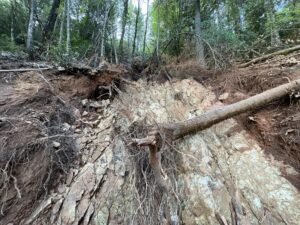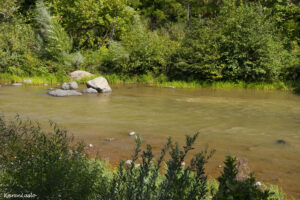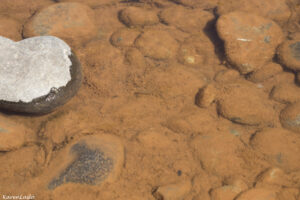The failure of the PG&E-operated Butte Canal that caused a landslide into Butte Creek last week, turning the water a sludgy-orange, is under investigation by the law enforcement arm of the state’s Department of Fish & Wildlife.

“We’re very aware of the situation there,” said Peter Tira, an information officer for the department. “Butte Creek has the largest spring run of wild Chinook salmon in California, and that’s the reason we monitor it so closely.”
Tira said today that game wardens have so far found one carcass, but that doesn’t mean that more of the Chinook haven’t perished. The water began clearing after one and a half days, with the orange-ish sediment settling along the creek sides, but the creek middle is still murky, making the search for salmon challenging.
“The turbidity has improved quite a bit since last week when the situation occurred,” Tira said, “but it’s not an easy thing to look for.”

Tira said the leak occurred during the night previous to the discovery by PG&E early the morning of Aug. 10.
Meanwhile, testing is underway on the water quality by PG&E as well as at the university. But the murkiness in the water didn’t deter swimmers at Butte Creek Sunday where the Covered Bridge was once located.
PG&E said the breach occurred between the forks of Butte Creek and Butte Creek Head Dam in the gunite near the bottom of the canal early Aug. 10. “In the early afternoon, (sic) identified turbidity in the creek,” said a statement from the power company. “PG&E immediately notified state and federal resource agencies and patrolled the creek and canal by helicopter.”
Zeke Lunder, a hydrology and wildfire expert who publishes the blog, “The Lookout,” said removing debris from what is a “huge pile of rubble” created by the landslide will be difficult.
“Thousands of yards of dirt and rock dammed up Butte Creek,” Lunder said on The Lookout Facebook page, noting that video shows an “entire gravel bar” that is new. (See video at bottom of story.)
“The landslide went all the way across the creek and created a temporary dam.”
Lunder has hiked part of the landslide route and told ChicoSol that the breach itself appears to have been “surprisingly small.” But as the canal water gushed downward it created a “big mess” that got larger, washing away soil and taking out large trees.
What Lunder called a “big dam of dirt” blocked the creek flow for a period of time. “Then the creek flooded over the dam,” he said, and people downstream “began to see really heavy mud.”

Tira said officials from Fish & Wildlife were in discussions last week about whether PG&E should be allowed to move heavy equipment into the creek bed to remove the debris, or whether that would “make things worse” and cause more disruption.
Allen Harthorn, founder of Friends of Butte Creek, said removing the “mountain” of sediment will be a “multi-million dollar effort.”
“There’s so much material, they’d need dump trucks,” Harthorn said. “And there’s no way to get equipment down there.”
Harthorn suspects that the canal leak ran for “many, many hours” before state officials were notified.
Friends of Butte Creek has been working to restore habitat on the creek and says only 500 salmon returned to the fresh waters this past spring that are now in danger of perishing. Even if the water is now clearer, Harthorn said the salmon “went through two days of total inundation.”
“They’ve been struggling for oxygen for two days, and the hot weather doesn’t help,” he noted.
Another danger, Lunder said, is that those that spawn will leave eggs that get buried in the mud.
Harthorn is also concerned about the water quality. For example, asbestos is found in serpentine soils, and it’s unclear yet whether the landslide involved this type of soil.
Residents of Butte Creek Canyon, Harthorn said, are “up in arms” and aware that this will hurt the wildlife as well as their property values. “This type of event lowers the property value of every single home in the canyon,” Harthorn said. “We live in a pristine watershed. That has been destroyed.”
But the biggest worry is the spring-run salmon, which Harthorn as well as other others have spent decades trying to save. Those salmon began returning from the ocean this past March, and haven’t eaten since leaving their ocean habitat. “They come loaded with good fat to carry into the fall when they spawn,” Harthorn said, “but now they’ve been four to five months without eating, getting weaker and weaker by the day.
“To have this slam them during the month before they spawn is particularly hazardous to their survival,” he said.
Harthorn blames PG&E for poor facility maintenance of the flumes — which were originally constructed for gold mining in the 1800s — and wants to see the company held accountable. A letter-writing campaign is underway and Harthorn said members of the public should “saturate these agencies with complaints about this.”
PG&E spokesman Paul Moreno said Aug. 14 that PG&E has completed repairs on the canal and is waiting for the concrete to cure. It will then seek regulatory approval to put the canal back in operation. He declined comment on whether the canal had been neglected, saying only that the power company is “investigating the cause of the breach.”
Leslie Layton is editor of ChicoSol.
(Video below was shot by a resident of Butte Creek Canyon and shows canal water gushing down the side of the canyon and leaving a mountain of orange-colored sediment. Video courtesy of The Lookout.)

This is so deeply disturbing. Thank you, ChicoSol, Allan Harthorn, and Friends of Butte Creek for keeping us informed about this environmental disaster. Sadly, whether or not PG&E is held accountable, it sounds like nothing can repair the damage this breach has done to the precious Butte Creek spring salmon run and the entire Butte Creek ecosystem.
We’ve known for years that PG&E is too big to keep up with their responsibilities, leaving disaster after disaster in the wake of their ineptitude. Break ’em up!